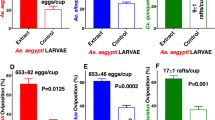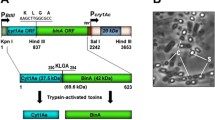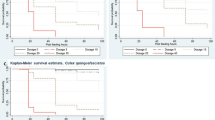Summary
The larvicidal power of more than 180 Bacillus sphaericus strains belonging to six H serotypes has been assayed on Culex pipiens, Anopheles stephensi and Aedes aegypti under standardized conditions. The most potent strains are distributed into serotype H5a5b, generally toxic to the three mosquito species, and serotypes H6 and H25, toxic to C. pipiens and A. stephensi. Strains of serotypes 26a26b and H2a2b are much less toxic and most often only on C. pipiens. The relative potency of each strain can be expressed by specific titres on the different mosquito species and by activity ratios derived from such titres.
Similar content being viewed by others
References
Barjac H de (1989) Classification of B. sphaericus strains and comparative toxicity to mosquito larvae. In: Barjac H de, Sutherland D (eds) Bacterial control of mosquitoes and blackflies, chapter 14, Rutgers University Press
Barjac H de, Charles J-F (1983) Une nouvelle toxine active sur les moustiques, présente dans des inclusions cristallines produites par Bacillus sphaericus. CR Acad Sci [III]:905–910
Barjac H de, Larget-Thiery I (1984) Characteristics of IPS82 as standard for biological assay of Bacillus thuringiensis H14 preparations. WHO Mimeogr Doc WHO/VBC/84.892
Barjac H de, Larget-Thiery I, Cosmao Dumanoir V, Ripouteau H (1985) Serological classification of Bacillus sphaericus strains in relation with toxicity to mosquito larvae. Appl Microbiol Biotechnol 21:85–90
Barjac H de, Thiery I, Cosmao Dumanoir V, Frachon E, Laurent Ph, Ofori J, Charles J-F, Hamon S (1988) Another Bacillus sphaericus serotype harbouring strains very toxic to mosquito larvae: serotype H6. Ann Inst Pasteur Microbiol 139:363–377
Baumann P, Unterman BM, Bauman L, Broadwell AH, Abbene SJ, Bowditch RD (1985) Purification of the larvicidal toxin of Bacillus sphaericus and evidence for high-molecular-weight precursors. J Bacteriol 163:738–747
Baumann L, Broadwell AH and Baumann P (1988) Sequence analysis of the Mosquitocidal Toxin Genes Encoding 51.4 and 41.9 Kilodalton Proteins from Bacillus sphaericus 2362 and 2297. J Bacteriol 170:2045–2050
Davidson EW (1982) Purification and properties of soluble cytoplasmic toxin from the mosquito pathogen Bacillus sphaericus strain 1593. J Invertebr Pathol 39:6–9
Dulmage HD (1981) Insecticidal activity of isolates of Bacillus thuringiensis and their potential for pest control. In: Burges D (ed) Microbial contro of pests and plant diseases 1970–1980, Academic Press, London, pp 193–222
Kalfon A, Larget-Thiery I, Charles J-F, Barjac H de (1983) Growth, sporulation and larvicidal activity of Bacillus sphaericus. Eur J Appl Microbiol Biotechnol 18:168–173
Kellen WR, Clark TB, Lindegren JE, Ho BC, Rogoff MH, Singer S (1965) Bacillus sphaericus Neide as a pathogen of mosquitoes. J Invertebr Pathol 7:442–448
Lysenko O, Davidson EW, Lacey LA, Yousten AA (1985) Five new mosquito larvicidal strains of Bacillus sphaericus from non-mosquito origins. J Am Mosq Control Assoc 1:369–371
Myers PS, Yousten AA (1980) Localization of the mosquitolarval toxin of Bacillus sphaericus 1593. Microbiology 39:1205–1211
Singer S (1977) Isolation and development of bacterial pathogens of vectors. In: Biological regulation of vectors. HEW Washington, D.C. Publication no. (NIH) 77-1180, pp 3–18
Thiery I (1988) Evaluation et contrôle au laboratoire du pouvoir entomopathogène de Bacillus thuringiensis var. israelensis et de Bacillus sphaericus sur larves de Culicidae (Diptères, Nématocères). Thèse de Docteur en Science de la Vie de l'Université Paris XI
Weiser J (1984) A mosquito-virulent Bacillus sphaericus in adult Simulium damnosum from Northern Nigeria. Zentralbl Mikrobiol 139:57–60
Wickremesinghe RSB, Mendis C (1980) Bacillus sphaericus spore from Sri Lanka demonstrating rapid larvicidal activity on Culex quinquefasciatus. Mosq News 40:387–389
Yousten AA, Davidson EW (1982) Ultrastructural analysis of spores and parasporal crystals formed by Bacillus sphaericus. Appl Environ Microbiol 44:1449–1455
Author information
Authors and Affiliations
Rights and permissions
About this article
Cite this article
Thiery, I., de Barjac, H. Selection of the most potent Bacillus sphaericus strains based on activity ratios determined on three mosquito species. Appl Microbiol Biotechnol 31, 577–581 (1989). https://doi.org/10.1007/BF00270798
Received:
Accepted:
Issue Date:
DOI: https://doi.org/10.1007/BF00270798




